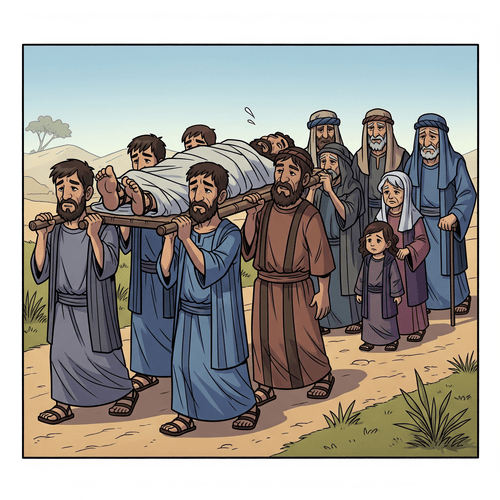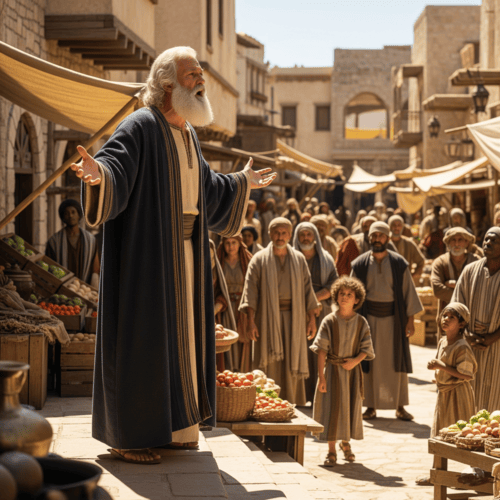Isaiah’s Servant Songs: Why Are They Central to Messianic Prophecy?
Isaiah’s Servant Songs: Few passages in the Old Testament capture the grand sweep of God’s redemptive purpose with such clarity and power as do these songs of Isaiah. Embedded within chapters 40-55 of Isaiah’s prophecy, the four remarkable poems are cornerstones of Messianic prophecy. Their significance extends far beyond mere literary beauty—they offer us profound glimpses into the nature, mission, and suffering of the coming Messiah.
What makes these ancient prophecies so central to our understanding of Christ and His work? Why have Reformed theologians throughout history returned to these texts with such persistent attention? The answers lie not only in their explicit Messianic content but in their profound illumination of God’s sovereign purpose in redemption.
THE SONGS’ HISTORICAL CONTEXT
Isaiah ministered during one of the most turbulent periods in Israel’s history, spanning the reigns of several kings of Judah (approximately 739-686 BC). The era saw the devastating rise of Assyrian power, the fall of the northern kingdom of Israel, and the growing shadow of Babylonian influence. The prophet spoke to a people wrestling with national crisis, spiritual decay, and the looming threat of exile.
The historical setting of these prophecies Is particularly significant to understand their impact. Isaiah delivered these words to a nation teetering between faith and apostasy, between trust in divine promises and reliance on political alliances. The Servant Songs emerge from this context not as mere political commentary but as radical declarations of God’s faithful commitment to His covenant promises despite His people’s failures.
THE FOUR SERVANT SONGS
The First Song (Isaiah 42:1-9): The Servant’s gentle character shines through in this inaugural song, where He is portrayed as one who “will not cry aloud or lift up his voice in the streets” yet carries divine authority. Gentleness is paired with unwavering purpose, as the Servant is commissioned to “bring forth justice to the nations.” This combination of gentleness and authority perfectly characterises Christ’s first advent—He came not as a political revolutionary but as the suffering servant who would establish justice through His perfect obedience and sacrificial death.
The Second Song (Isaiah 49:1-13): The divine calling of the Servant “from the womb” demonstrates God’s sovereign election and precise purpose in His plan of redemption. In a stunning paradox, the Servant’s mission expands from restoring Israel to becoming “a light for the nations,” revealing the universal scope of God’s redemptive purpose. This dual role beautifully illustrates the Reformed understanding of how Christ fulfils both the particular promises to Israel and extends salvation to the elect from all nations.
The Third Song (Isaiah 50:4-9): Here we see the Servant’s perfect obedience as He submits to the Father’s will, even in the face of suffering and shame. The Servant’s unwavering trust in divine vindication prefigures Christ’s steadfast faith during His passion. The song powerfully demonstrates the Reformed doctrine of Christ’s active obedience, showing how He perfectly fulfilled all righteousness on behalf of His people.
The Fourth Song (Isaiah 52:13-53:12): The most detailed of the Servant Songs presents the full revelation of the Servant’s substitutionary suffering and ultimate exaltation. In these verses, we find the clearest Old Testament picture of penal substitution, where the Servant bears the punishment deserved by others. The song concludes with the Servant’s triumph and exaltation, foreshadowing Christ’s resurrection and present reign, while the specific language of bearing the sins of “many” (rather than all) aligns with the Reformed understanding of particular redemption.
THE SONGS’ SIGNIFICANCE IN CHRISTOLOGY
- They Point to Christ as the Ultimate Fulfillment: The Servant Songs find their complete and perfect fulfillment in Jesus Christ, who embodies every detail of these prophecies written centuries before His incarnation. The New Testament writers repeatedly draw from these texts, showing how Jesus’ ministry, suffering, death, and exaltation correspond precisely to Isaiah’s prophecies. The fulfillment isn’t merely typological but represents the very purpose for which these prophecies were given. They demonstrate God’s sovereign control over history and revelation.
- They’re Extensively Quoted in the New Testament: The New Testament’s use of the Servant Songs is extensive and deliberate, with direct quotations appearing at crucial moments in the gospel narratives and apostolic teaching. Matthew’s gospel particularly employs these passages to demonstrate Jesus’ identity as the promised Messiah, while both Peter and Paul draw heavily from Isaiah 53 in explaining the meaning of Christ’s death. This shows the early church understood Jesus’ ministry through the lens of the Servant Songs, not as an afterthought, but as the intended interpretation.
- They Shout Divine Authorship: Reformed interpretation emphasises the unity of Scripture and sees in the Servant Songs a prime example of how the Old Testament anticipates and promises what the New Testament fulfils and explains. This approach recognises that while the immediate hearers may have understood these prophecies partially, their full significance can only be grasped in light of Christ’s coming. The clarity with which these songs portray Christ’s person and work demonstrates the divine authorship of Scripture and the certainty of God’s promises.
THE SONGS’ THEOLOGICAL IMPLICATIONS
They Show Us Our Salvation Was Always on God’s Mind
The Servant Songs play a crucial role in demonstrating the unity of God’s redemptive purpose throughout Scripture. They show how the promises made to Israel find their ultimate fulfillment not in the nation itself but in Christ, who perfectly fulfils Israel’s calling and extends its blessings to all nations. These songs also reveal how the covenant of grace—established in eternity past—unfolds in history through promise and fulfillment, with Christ as its mediator and guarantor.
They Promise What Would Be Fulfilled Centuries Later
The promise-fulfillment paradigm—the detailed correspondence between these prophecies and their fulfillment in Christ—establishes a pattern that helps us understand how God works in history. It demonstrates both God’s faithfulness to His promises and His sovereign control over historical events to bring about His purposes. The precision of fulfillment strengthens our confidence in God’s other promises and helps us interpret prophetic literature with Christ at the centre.
They Speak of the Servant’s Central Role in Salvation
Reformed soteriology borrows heavily from the Servant Songs’ portrayal of salvation as entirely God’s work through His chosen Servant. The songs emphasise key Reformed distinctives: particular redemption in the Servant bearing the sins of “many,” effectual calling in the Servant’s success in saving all those given to Him, and the necessity of substitutionary atonement in the detailed description of the Servant’s suffering for others. These doctrinal emphases emerge naturally from the text rather than being imposed upon it.
They Hint at the Unity in Redemptive History
The Servant Songs demonstrate how God’s plan of redemption maintains perfect continuity from Old Testament to New, while also showing progression in revelation. They reveal how apparently diverse elements of biblical theology—promises to Israel, universal blessing to the nations, suffering and glory, divine sovereignty and human responsibility—find their coherence in Christ. This unity strengthens our understanding of Scripture as a single, unified revelation of God’s redemptive purpose.
THE SONGS’ CONTEMPORARY RELEVANCE
- They Draw Attention to Christ’s Person and Work: In an age of theological confusion, the Servant Songs provide a clear biblical foundation for understanding Christ’s person and work. They offer powerful responses to modern challenges to substitutionary atonement and help us articulate why Christ’s suffering was both necessary and sufficient for our salvation. Their detailed prophecies also serve as a powerful apologetic tool, demonstrating the supernatural nature of biblical revelation to an increasingly sceptical world.
- They’re Foundational to Christ-Centred Preaching: The Servant Songs show preachers how to interpret and proclaim Old Testament texts in light of their fulfillment in Christ. The Servant Songs equip ministers to navigate between the extremes of moralistic preaching and allegorical interpretation, demonstrating how to preach the Old Testament both historically and Christo-centrically. Their rich imagery and profound theological content provide resources for preaching that are both doctrinally robust and pastorally applicable.
- They’re Relevant to Christian Apologetics: In our pluralistic age, the Servant Songs offer compelling evidence for the unity and divine inspiration of Scripture. They demonstrate the Bible’s unique ability to predict and explain Christ’s coming centuries in advance, providing a powerful testimony to its supernatural origin. These prophecies also help answer common objections about Christianity’s claims regarding Jesus, showing how His suffering and death were not unexpected developments but part of God’s eternal plan.
ISAIAH’S SERVANT SONGS—CONCLUSION
The Servant Songs of Isaiah are towering monuments in the landscape of biblical prophecy, their significance extending far beyond their original context to illuminate the very heart of God’s redemptive purpose in Christ. These ancient texts continue to captivate, challenge, and comfort God’s people, offering a profound testimony to divine sovereignty and grace. As we face the challenges, they remind us our faith rests not on human wisdom but on God’s eternal purpose, revealed in Scripture and fulfilled in Christ. In studying these songs, we not only deepen our understanding of prophecy but are drawn into a richer appreciation of the One who came as the Suffering Servant and now reigns as the Exalted Lord. Their enduring relevance calls us to renewed wonder at God’s perfect plan and deeper trust in His unfailing promises.
ISAIAH’S SERVANT SONGS—RELATED FAQs
Why are these passages called “Servant Songs”? The term “Servant Songs” was coined by German scholar Bernhard Duhm in 1892, who identified these four passages as distinct poetic units within Isaiah that focus on a mysterious figure called the “Servant of the LORD.” While the label itself is relatively modern, these passages share unique literary and thematic characteristics that set them apart from surrounding texts. The designation has proven helpful for studying and understanding these crucial messianic prophecies, though it’s important to note that they are interconnected with the broader message of Isaiah.
- How does the First Servant Song (Isaiah 42:1-9) relate to Jesus’ baptism? The Father’s declaration “This is my beloved Son, with whom I am well pleased” at Jesus’ baptism directly echoes the language of Isaiah 42:1. This connection demonstrates how the early church and Gospel writers understood Jesus as the fulfillment of the Servant’s role. The Spirit’s descent upon Jesus at His baptism also parallels the emphasis on the Spirit’s role in empowering the Servant for His mission.
- What makes the Second Servant Song (Isaiah 49:1-13) unique in its worldwide scope? This song dramatically expands the Servant’s mission from Israel’s restoration to a global purpose, declaring that being Israel’s deliverer would be “too light a thing.” The text introduces a striking paradox where the Servant experiences apparent failure in His mission to Israel yet achieves an even greater success in bringing salvation to the Gentiles. This universal scope particularly resonates with the New Testament’s emphasis on the global nature of Christ’s church.
How does the Third Servant Song (Isaiah 50:4-9) illuminate Christ’s daily life? This song provides unique insight into the Servant’s daily devotional life and learning posture, showing Him as one who listens to God “morning by morning.” It reveals the intimate relationship between the Father and Son, highlighting aspects of Christ’s human experience that the Gospels only hint at. The emphasis on the Servant’s willing suffering and confidence in God’s vindication helps us understand Jesus’ mindset during His earthly ministry.
- Why is the Fourth Servant Song (Isaiah 52:13-53:12) considered the “Holy of Holies” of Old Testament prophecy? This culminating song contains the most detailed and profound description of vicarious suffering in the Old Testament, with specific details that found precise fulfillment in Christ’s passion. The song’s structure moves from the Servant’s exaltation to His humiliation and back to exaltation, providing the theological framework for understanding Christ’s death and resurrection. Its influence on New Testament theology is unparalleled, being quoted or alluded to over 40 times.
- How do the Servant Songs progressively reveal the Servant’s identity? Each song builds upon the previous ones, creating an increasingly detailed portrait of the Servant’s identity and mission. The progression moves from a general introduction of the Servant’s character (First Song), to His mission’s scope (Second Song), His personal experience (Third Song), and finally His substitutionary suffering and triumph (Fourth Song). This progressive revelation demonstrates divine wisdom in gradually unfolding the full picture of Christ’s person and work.
Why do some scholars argue the Servant represents Israel rather than Christ? While some elements of the Servant Songs echo Israel’s role and experience, the personal nature of the descriptions and the Servant’s mission to Israel itself point beyond corporate Israel to an individual figure. The Servant’s sinlessness and vicarious suffering on behalf of others cannot be reconciled with a purely corporate interpretation. Reformed theology recognises that while Israel serves as a type of the Servant, the songs find their true and final fulfillment in Christ.
ISAIAH’S SERVANT SONGS—OUR RELATED POSTS
Editor’s Pick

Blue Whales: Mammoth Icons of Intelligent Design
Imagine an animal so massive its heart alone weighs as much as a small car, yet so precisely engineered it [...]

Do Unbelieving Kids Disqualify Church Leaders?
REFORMED PERSPECTIVES ON 1 TIMOTHY 3 AND ELDER QUALIFICATIONS Every pastor knows the heartbreak. A faithful elder who has served [...]

Why Did God Kill Onan? Wasn’t the Punishment Disproportionate?
The story of Onan in Genesis 38 troubles many. Why would God strike down a man for what seems like [...]

Is God Preparing Me for Ministry? How May I Know for Sure?
The question haunts many faithful believers. You’re serving faithfully in your local church, perhaps teaching Sunday school or leading a [...]

Ephesians 1:13: Was the Spirit’s Indwelling Promised of Old?
When Paul declares believers are “sealed with the promised Holy Spirit” in Ephesians 1:13, one word jumps off the page: [...]

Monergism vs Synergism: Is Salvation God’s Work Alone?
When God saves us, does He do it alone, or does He need our help? The question isn’t mere theological [...]

Was Jesus Abandoned by the Father on the Cross?
WHY WE ANSWER IN THE NEGATIVE “My God, my God, why have you forsaken me?” These words from the cross [...]

Why Do Some Respond to God’s Call While Others Don’t?
THE REFORMED VIEW ON OUTWARD AND INWARD CALLS EXPLAINED Picture this: Two neighbours attend the same church service. They hear [...]

Does Ocean Salt Content Prove a Young Earth?
A COMPELLING LOOK AT MARINE CHEMISTRY AND EARTH’S TIMELINE The Salt Question That Challenges Deep Time: If Earth’s oceans have [...]
Noah’s Flood: Where Did All the Water Come From? And Go?
The question hits every Bible-believing Christian at some point: “If Noah’s flood covered the whole earth, where did all that [...]






